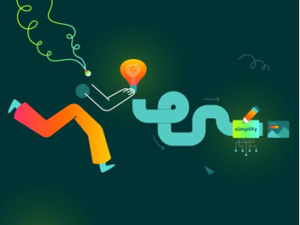Butterfingers. Shall we ask for a better quality of door so we can escape? Be a pal and tell me, Am I a good man? As we learn about each other, so we learn about ourselves.
Butterfingers. Shall we ask for a better quality of door so we can escape? Be a pal and tell me, Am I a good man? As we learn about each other, so we learn about ourselves.
It’s well-known that when someone introduces themselves as a designer, they could mean a multitude of things. With ‘designer’ becoming an ever more popular career path, it’s easy to get confused by all the job titles that fall under the design umbrella and how they differ from each other. Digital design is no exception.
When you hear ‘digital design,’ what comes to your mind? Is it web design? Maybe UX or UI design? Perhaps even graphic design, or something more specific like illustration or animation?
The answer is all of the above.
Digital design is an umbrella term that encompasses several different roles and disciplines. It’s the process of mapping out the look and feel of the content that people view and interact with on a digital interface. Digital designers do more than design graphics; it’s all about creating designs crafted for specific devices, taking into account factors like user experience, interactivity, and overall aesthetic balance.

The difference between digital design and graphic design
Graphic design is for print products and digital design is for digital content. This is, of course, a generalization. These days the realms of print and digital overlap more often than not. Many digital designs rely on skills from the graphic designer’s playbook, such as brand implementation and typographical layout. Graphic design projects, meanwhile, commonly have to account for digital distribution in addition to print. And to make matters more confusing, “graphic design” is commonly used as a catch-all term for every type of visual communication.
At the end of the day, a designer is often expected to have skills in both graphic and digital design no matter which one they specialize in. The difference comes down to the medium (print or digital) in which viewers will most commonly encounter the design product. Digital designs must take into account user interaction whereas graphic designs are designed for static visual impact.
Thus,
“Digital design refers to what is created and produced for viewing on a screen.”
In an increasingly digitized world, it’s likely that as a designer, you will be working quite a bit with digital design. Whether you’re a UX designer or a graphic artist, understanding the specifics of designing for digital platforms will help you take your career to the next level.
To give a thumbnail, basic digital design skills and tools include things like:
- Color Theory
- Typography
- Adobe Photoshop
- Adobe Illustrator
- Adobe InDesign
- Figma
Digital vs. Print Design: How Are They Different?
At first glance, it may seem as though digital design and print design are very similar. However, there are some crucial differences to keep in mind when designing for these two types of media.
Different Kinds of Deliverables
Since digital and print designs appear in different places, it is up to designers to familiarize themselves with the types of deliverables they may be asked for.
Among other things, digital designers may create:
- Banner ads
- Infographics
- Website elements
- UX wireframes
- Graphics for reports and white papers (PDFs)
Print designers would be more likely to create:
- Brochures
- Magazine spreads
- Book covers
- Business cards
- Print ads
Interactivity in digital design
Another key characteristic of digital design is interactivity. Beyond being aesthetically pleasing, your design needs to be usable, with a focus on how your user will interact with it. This is important no matter what medium you’re designing for, from web design to mobile app design and other mediums like wearables. As technology advances, digital designers face the challenge of creating for a variety of screen sizes, all with various uses and contexts.
Analytics in digital design
Data and analytics also play a role in defining digital design, as they allow a designer to gauge the product’s performance. It is difficult to track the performance of a physical flyer or brochure, but a digital design does not face the same problem. By reviewing performance indicators such as likes, shares, downloads, and pageviews, you’ll get a better understanding of how effective your design is.
The introduction of analytics and data also empowers the digital designer to make data-informed design decisions throughout the design process. For example, digital designers often run A/B tests to collect qualitative data about two (or more) designs. This added layer of analytics in digital design is a key differentiator between digital and graphic design.
Diving into UX and UI design
So when we talk about what a UX designer does, are they more of a digital designer or a graphic designer? UX is all about the user and the experience they have with your product or website, so it goes hand-in-hand with digital design. UX designers incorporate user research and analytics into their design decisions, combining qualitative and quantitative data to create meaningful and relevant experiences for their users.
Diving even further, how about UI design? This is the visual communication component of UX design. UI designers focus on visual design elements like layout design, iconography, and user flows. Most UI designers work with a design system in order to remain consistent between pages and areas of their website, app, or product.
UI design is one area of digital design where the line continues to blur with graphic design. Graphic designers sometimes help out in areas of UI design, such as designing logos and icons. The key characteristic is that these are static elements of UI design and do not take user flows or movement into account.
Final thoughts
Although the lines have begun to blur between graphic and digital design, it is important to know the key differences of each. Graphic designers tend to work on static images, traditionally in print, while digital designers focus on anything that will end up on a screen. Although these skills can interchange at some levels, there are several stark differences. Both yield exciting and creative career paths and it is up to you to decide which route to take.
